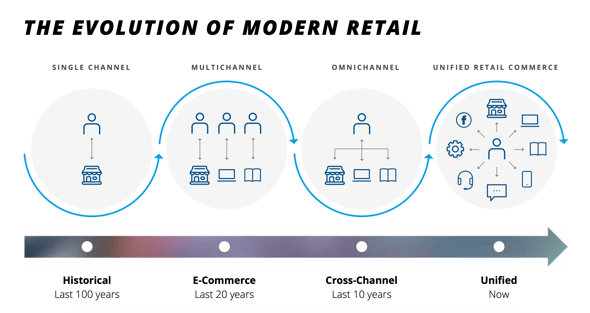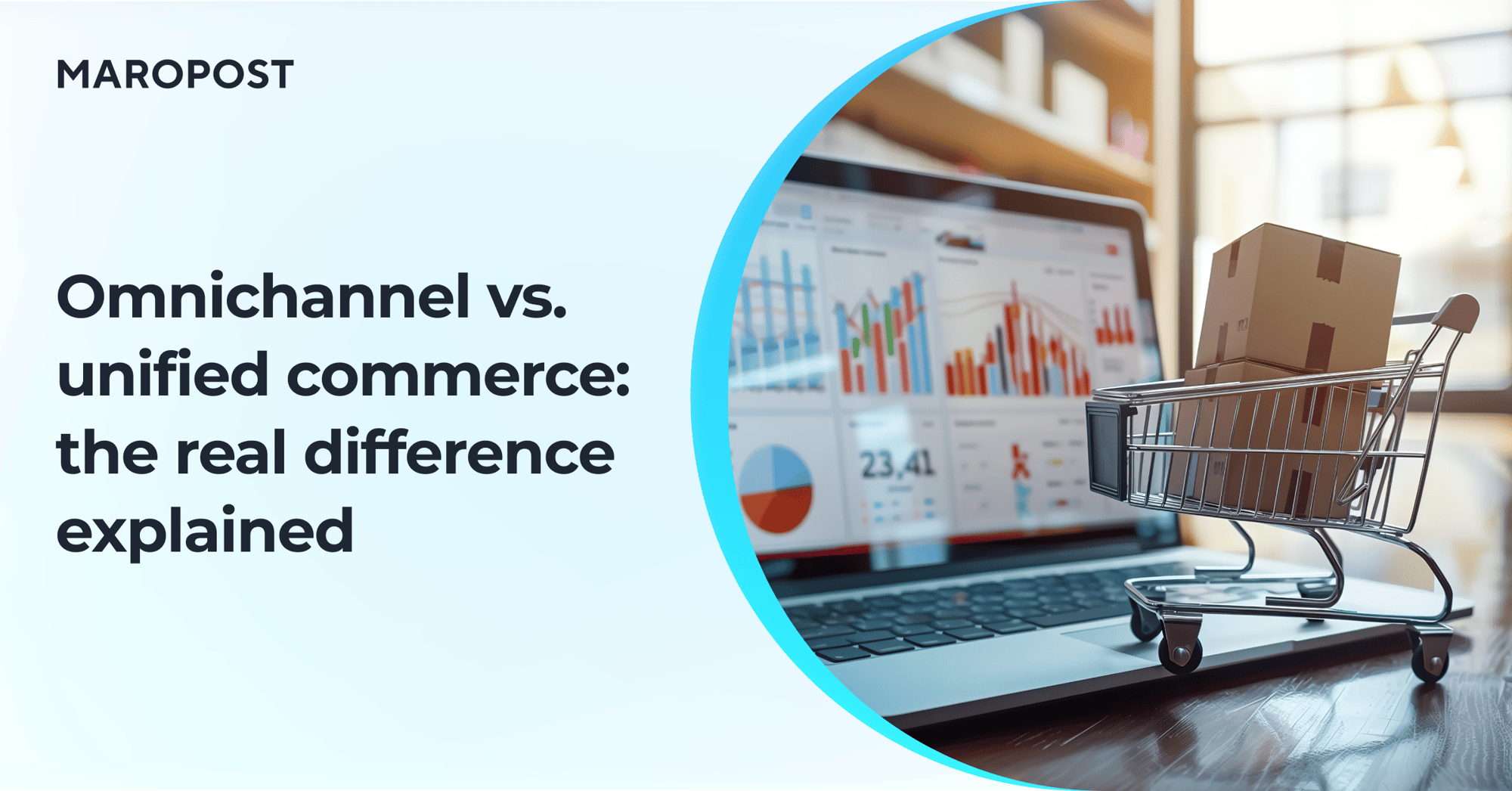TL;DR
- Omnichannel commerce aims to deliver a seamless CX across all channels, but its underlying systems often remain fragmented and not fully synced in real time.
- Unified commerce connects all front-end and back-end systems within one platform and provides a single source of truth for all operations (ecommerce, POS, inventory management, marketing, and support).
- Key benefits of unified commerce include better customer experiences, real-time inventory visibility, unified customer data, lower total costs, and increased sales and loyalty.
- Maropost’s Unified Commerce platform enables retailers to run their entire business from one platform, ensuring consistency, personalization, and better operational efficiency.
Unified commerce is becoming the new industry standard. And rightly so. Today’s consumers increasingly demand consistent shopping experiences no matter where and how they shop. They want to browse, purchase, and receive products seamlessly across digital and physical channels, often blending several touchpoints in a single shopping journey. This requires all your back-end systems to work together in harmony – and unified commerce makes that possible.
But here’s the catch: many retailers are still confusing unified commerce with omnichannel commerce. While these two terms are often used interchangeably, they actually represent different approaches. So, what’s the difference between the two? And, most importantly, which approach is right for your business?
In this article, we’ll outline the key differences between omnichannel and unified commerce. On top of that, by the end, you’ll understand why unified commerce is the future of modern retail.
What is omnichannel commerce?
Omnichannel commerce focuses on the customer experience. The primary goal of an omnichannel commerce approach is to create a seamless experience for shoppers across all your sales channels. It means they can move smoothly between various touchpoints, accessing the same product information, offers, and services wherever they shop – online or in-store.
But while all the channels appear to act as one, the reality is quite different. They are typically connected via APIs, which means the data (such as inventory, customer details, purchase histories, marketing activities, and service interactions) may not be synchronized in real time across all systems. So, even though shoppers enjoy what feels like a frictionless experience, your underlying back-end systems remain fragmented behind the scenes.
What is unified commerce?
Unified commerce is the next evolutionary step of omnichannel commerce. It connects both your customer-facing channels and back-end systems through a single platform. Ultimately, it creates a single source of truth for all your operations, including ecommerce, point-of-sale (POS), inventory management, marketing, and customer support.
In practice, it means you get access to everything you need to know about each customer’s journey in real time – and it enables you to give your shoppers the most relevant, consistent, and personalized experience. No disjointed systems, no scattered customer data. Better yet, you can manage all your ecommerce and retail operations from a single unified commerce platform.

Image source: Deloitte
Recommended reading: What is unified commerce? A complete 2026 guide
What are the benefits of unified commerce?
Let’s now explore the benefits of a unified commerce strategy in more detail:
- Next-level customer experience: According to research from TCS OmniStore and RIS News, 77% of retailers believe unified commerce provides a seamless experience. And when shoppers move effortlessly between channels with consistent inventory visibility, pricing, purchase history, and loyalty status – the experience improves and customer satisfaction increases.
- Reliable real-time inventory management: Poor inventory management leads to lost sales due to stockouts and damaged customer trust from overselling. Unified commerce platforms let you manage inventory across all your stores and channels in real time. That reduces the risks of stockouts and prevents damaged customer trust from overselling.
- Unified customer profiles: Unified commerce consolidates all customer data – browsing behavior, purchase history, in-store visits, mobile app behavior, returns, customer service interactions – into a single comprehensive profile. That enables you to send more relevant offers, personalize support interactions, and improve customer loyalty.
- Lower total cost of ownership (TCO): Though the initial investment in a unified commerce platform can be significant, it leads to a lower TCO over time compared to maintaining multiple disparate systems. Based on Shopify’s data, businesses using unified commerce platforms report 22% lower total cost of ownership versus multi-vendor stacks that require ongoing integration work.
- Increased sales and revenue: Finally, with unified inventory, complete customer profiles, and better customer experiences, you can expect higher conversion rates, larger basket sizes, and more customer lifetime value. According to the 2025 Retail Capability Index report, retailers that implement unified commerce see 3x revenue growth and 1.7x higher customer lifetime value.
Key differences between omnichannel vs. unified commerce
|
Omnichannel Commerce
|
Unified Commerce |
|
| Focus |
Connecting channels for the customer |
Unifying the entire business operation around the customer |
| Technology Stack |
Multiple, separate systems for each channel that are typically linked via APIs or middleware |
A single, centralized platform that natively integrates all systems (front-end and back-end) |
| Data Management |
Data is often siloed by channel, requiring complex synchronization or aggregation to get a full view |
Single source of truth for all data (customer, inventory, orders) accessible in real-time across all touchpoints |
| Customer Experience | Consistent experience across channels, but slight friction or information gaps can occur |
Truly seamless experience: customers can start, continue, and finish interactions across any channel without disruption |
| Analytics and Reporting | Insights are fragmented and channel-specific |
Unified data allows for holistic, real-time insights across all operations |
| Implementation Complexity |
Easier to implement incrementally, but harder to maintain consistency |
More complex initial setup but delivers superior long-term efficiency and scalability |
|
Cost Implications |
Ongoing costs for maintaining multiple systems and their integrations |
Potentially higher initial investment, but lower Total Cost of Ownership (TCO) over time due to reduced integration and maintenance |
| Example Scenario | A retailer offers online shopping, in-store pickup, and mobile app, but systems don’t fully sync inventory or order history | The same retailer’s online, mobile, and in-store systems operate from one source of truth, syncing inventory, pricing, and customer data in real time |
Omnichannel vs. unified commerce: which is better for 2026?
As customer expectations keep climbing, unified commerce sets the gold standard for how retail businesses manage the entire customer journey. If you want to stay competitive in 2026 and beyond – unified commerce is a better strategy for your business. It empowers you to deliver next-gen customer experiences and helps improve customer loyalty and retention.
Just take a look at the stats from the Adyen Agility Report Australia:
- 53% of consumers say they would be more loyal to a retailer that lets them buy things online and return them in-store.
- 39% would be more loyal to a retailer that enabled them to shop in-store and finish shopping online, or vice versa.
- 42% say they prefer retailers who remember their preferences and previous shopping behaviors to create a more tailored shopping experience.
- 72% say they won't shop with retailers where they've had a bad shopping experience, either in-store or online.
Unified commerce lets you meet your customers’ expectations by connecting every touchpoint into one frictionless experience. Whether someone starts shopping on social media, adds items to their cart online, or walks into your physical store to complete the purchase, everything is synced in real time. It means preferences are remembered, purchasing and returns are simple, and your brand feels consistent everywhere customers interact with it.
Recommended reading: Top 5 ecommerce trends you can't afford to miss in 2026
Make unified commerce a reality with Maropost
Omnichannel has been around for years, helping retailers connect their online and offline experiences. But let’s face it – it’s no longer enough. At Maropost, we believe that unified commerce is the future of retail because it solves the biggest challenge that omnichannel commerce could never fully overcome – disconnected systems.
That’s why we’ve built a truly unified commerce platform that lets you run your entire business from a single platform, whether you’re selling online, in-store, or anywhere in between.
Here's what becomes possible with the Maropost Unified Commerce platform:
- Centralized management: You manage your e-commerce storefronts, POS systems, product catalogs, and order fulfillment all from one platform, cutting down on "tool-chaos".
- Real-time inventory sync: You get one real-time view of all inventory across all warehouses, stores, and channels. This virtually eliminates overselling, stockouts, and those frustrating "out-of-stock" surprises.
- Hyper-personalization: You gain a unified view of each customer with every purchase, browsing history, and support interaction across all channels, so you can offer tailored recommendations and promotions that actually feel relevant.
- Scalability for growth: As your business grows, your platform grows with you. Whether you're adding new products, expanding into new markets, or opening more physical stores, Maropost can easily handle the increased volume and complexity.
Book a demo now to see how unified commerce can set your business up for success.
Frequently asked questions
What’s the core difference between omnichannel and unified commerce?
The core difference between unified commerce vs omnichannel lies in system architecture. Omnichannel ensures a consistent experience for shoppers by linking multiple channels that often operate separately, with no real-time data sync. A unified commerce approach takes it a step further by integrating all front-end and back-end functions into a single centralized platform, creating a single source of truth for all data. Unified commerce eliminates data silos and integration friction that omnichannel often struggles with.
When is omnichannel sufficient, and when should I upgrade to unified commerce?
Omnichannel may work well for your business if your channels share basic data, and your operations aren’t too complex. But once you’re managing multiple stores and regions and require real-time inventory accuracy and complex order fulfillment (like BOPIS or ship from store) – it’s time to move to unified commerce. This upgrade ensures better operational efficiency and decision-making as your business scales.
Is omnichannel commerce more expensive than unified commerce?
Initially, omnichannel can be cheaper as you can build it gradually using existing systems. But maintaining multiple disconnected platforms and complex integrations can become costly and inefficient in the long run. Unified commerce can have a higher upfront investment, but it eventually leads to a lower total cost of ownership (TCO) through simpler management, data accuracy, and automation.
What are the key technology requirements for implementing unified commerce?
To implement unified commerce, you need a robust unified commerce platform that can connect all your systems and operations – POS, inventory, ecommerce, order management, marketing automation, and customer service – into one centralized ecosystem. Ideally, the platform should also offer unified customer profiles, AI-driven personalization, advanced analytics and reporting, and flexible APIs for custom integrations. Maropost’s Unified Commerce platform checks all these boxes, bringing everything together so you can deliver truly connected, personalized experiences.


.png?width=1200&height=375&name=Large-Mobile-Banner-1200-px%20(1).png)